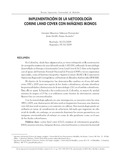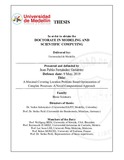Mostrar el registro sencillo del ítem
VS.Net Add-on for Optimal Definition of Black Box Software Testing Using Covering Arrays
Complemento de VS.Net para a definição ideal de testes de software de caixa-preta por meio de covering arrays;
Complemento de VS.NET para la definición óptima de pruebas de software de caja negra mediante arreglos de cobertura
| dc.contributor.author | Meneses Ruiz, Jaime Herney | |
| dc.contributor.author | Peña Velasco, Eduar Alexis | |
| dc.contributor.author | Cobos Lozada, Carlos Alberto | |
| dc.contributor.author | Timaná Peña, Jimena Adriana | |
| dc.contributor.author | Torres-Jimenez, Jose | |
| dc.date.accessioned | 2019-11-07T15:03:02Z | |
| dc.date.available | 2019-11-07T15:03:02Z | |
| dc.date.created | 2018-03-16 | |
| dc.identifier.issn | 1692-3324 | |
| dc.identifier.uri | http://hdl.handle.net/11407/5507 | |
| dc.description.abstract | Software testing can exceed 50% of the total cost of a software project, which is why companies need an alternative to reduce their cost and time of implementation. This research proposes the use of combinatorial structures known as Covering Arrays (CA) and Mixed Covering Arrays (MCA), which guarantee the detection up to 100% of errors with a minimum amount of testing. With this approach, a Visual Studio.NET add-on was developed for the optimization of the tests and its use was evaluated with students of last academic term of Computer Science Engineering and of a software company. The results obtained are promising and motivate the research group to disseminate its work at the national level. The research project was funded by the Vice-Principal Office of Research of the Universidad del Cauca. | eng |
| dc.description.abstract | Os testes de software podem superar 50% do custo total de um projeto de software, motivo pelo qual as empresas precisam de uma alternativa que permita reduzir seu custo e o tempo de sua realização. Esta pesquisa propõe o uso de algumas estruturas combinatórias conhecidas como covering arrays (CA) e mixed covering arrays (MCA), que garantem a detecção de até 100% dos erros com uma quantidade mínima de testes. Com esse enfoque, desenvolveu-se um complemento de Visual Studio.NET para a otimização dos testes e avaliou-se seu uso com estudantes do último semestre de Engenharia de Sistemas e de uma empresa de software. Os resultados obtidos são prometedores e motivam o grupo de pesquisa a divulgar seu trabalho nacionalmente. O projeto de pesquisa foi financiado pela Vice-reitoria de Pesquisas da Universidad del Cauca. | por |
| dc.description.abstract | Las pruebas de software pueden llegar a superar el 50 % del costo total de un proyecto de software, motivo por el cual las empresas necesitan una alternativa que permita reducir su costo y el tiempo de su realización. Esta investigación propone el uso de unas estructuras combinatoriales conocidas como arreglos de cubrimiento (CA) y arreglos de cubrimiento mixtos (MCA), que garantizan la detección hasta del 100 % de los errores con una mínima cantidad de pruebas. Con este enfoque, se desarrolló un complemento de Visual Studio.NET para la optimización de las pruebas y se evaluó su uso con estudiantes de último semestre de Ingeniería de Sistemas y de una empresa de software. Los resultados obtenidos son prometedores y motivan al grupo de investigación a divulgar su trabajo en el nivel nacional. El proyecto de investigación fue financiado por la Vicerrectoría de Investigaciones de la Universidad del Cauca. | spa |
| dc.format.extent | p. 121-137 | spa |
| dc.format.medium | Electrónico | spa |
| dc.format.mimetype | application/pdf | |
| dc.language.iso | spa | |
| dc.publisher | Universidad de Medellín | spa |
| dc.relation.uri | https://revistas.udem.edu.co/index.php/ingenierias/article/view/1646 | |
| dc.rights.uri | http://creativecommons.org/licenses/by-nc-sa/4.0/ | * |
| dc.source | Revista Ingenierías Universidad de Medellín; Vol. 17 Núm. 33 (2018): Julio-Diciembre; 121-137 | spa |
| dc.subject | Test cases | eng |
| dc.subject | Combinatorial tests | eng |
| dc.subject | Covering arrays | eng |
| dc.subject | Mixed covering arrays | eng |
| dc.subject | Simulated annealing | eng |
| dc.subject | .Net complement | eng |
| dc.subject | Casos de teste | por |
| dc.subject | Provas combinatórias | por |
| dc.subject | Covering arrays | por |
| dc.subject | Mixed covering arrays | por |
| dc.subject | Recozimento simulado | por |
| dc.subject | Complemento de .Net. | por |
| dc.subject | Casos de prueba | spa |
| dc.subject | Pruebas combinatorias | spa |
| dc.subject | Arreglos de cubrimiento | spa |
| dc.subject | Arreglos de cubrimiento mixtos | spa |
| dc.subject | recocido simulado | spa |
| dc.subject | Complemento de .Net | spa |
| dc.title | VS.Net Add-on for Optimal Definition of Black Box Software Testing Using Covering Arrays | eng |
| dc.title | Complemento de VS.Net para a definição ideal de testes de software de caixa-preta por meio de covering arrays | por |
| dc.title | Complemento de VS.NET para la definición óptima de pruebas de software de caja negra mediante arreglos de cobertura | spa |
| dc.type | Article | eng |
| dc.rights.accessrights | info:eu-repo/semantics/openAccess | |
| dc.identifier.doi | https://doi.org/10.22395/rium.v17n33a6 | |
| dc.relation.citationvolume | 17 | |
| dc.relation.citationissue | 33 | |
| dc.relation.citationstartpage | 121 | |
| dc.relation.citationendpage | 137 | |
| dc.audience | Comunidad Universidad de Medellín | spa |
| dc.publisher.faculty | Facultad de Ingenierías | spa |
| dc.coverage | Lat: 06 15 00 N degrees minutes Lat: 6.2500 decimal degreesLong: 075 36 00 W degrees minutes Long: -75.6000 decimal degrees | |
| dc.publisher.place | Medellín | spa |
| dc.creator.affiliation | Meneses Ruiz, Jaime Herney; ASMET Salud EPS | spa |
| dc.creator.affiliation | Peña Velasco, Eduar Alexis; ASMET Salud EPS | spa |
| dc.creator.affiliation | Cobos Lozada, Carlos Alberto; Universidad del Cauca | spa |
| dc.creator.affiliation | Timaná Peña, Jimena Adriana; Universidad del Cauca | spa |
| dc.creator.affiliation | Torres-Jimenez, Jose; Instituto Politécnico Nacional de México CINVESTAV | spa |
| dc.relation.references | [1] I. Burnstein, Practical software testing: a process-oriented approach, Luxemburgo: Springer Science & Business Media, 2006. | spa |
| dc.relation.references | [2] J. Tuya, et al., Técnicas cuantitativas para la gestión en la ingeniería del software, As Somozas: Netbiblo, 2007. | spa |
| dc.relation.references | [3] A. Mili y F. Tchier, Software Testing: Concepts and Operations, Nueva Jersey:Wiley Publishing, 2015. | spa |
| dc.relation.references | [4] S. Nidhra y J. Dondeti, “Black Box and White Box Testing Techniques ‒A Literature Review,” International Journal of Embedded Systems and Applications (IJESA), vol. 2, pp. 29-50, 2012. | spa |
| dc.relation.references | [5] S. Anand, et al., “An orchestrated survey of methodologies for automated software test case generation,” Journal of Systems and Software, vol. 86, pp. 1978-2001, 2013. | spa |
| dc.relation.references | 6] C. P. Jayaswal y T. U. o. T. a. Arlington, Automated Software Testing Using Covering Arrays, Texas: University of Texas at Arlington, 2006. | spa |
| dc.relation.references | [7] B. S. Ahmed, et al., “The development of a particle swarm based optimization strategy for pairwise testing,” Journal of Artificial Intelligence, vol. 4, pp. 156-165, 2011. | spa |
| dc.relation.references | [8] A. Arcuri y X. Yao, “Search based software testing of object-oriented containers,” Information Sciences, vol. 178, pp. 3075-3095, 2008. | spa |
| dc.relation.references | [9] G. J. B. T. S. C. Myers, The art of software testing, third edition. Hoboken, Nueva Jersey: John Wiley & Sons, 2012. | spa |
| dc.relation.references | [10] N. Changhai y H. Leung, “A Survey of Combinatorial Testing,” ACM Computing Surveys, vol. 43, pp. 11-29, 2011. | spa |
| dc.relation.references | [11] S. A. Bestoun yK. Z. Zamli, “A review of covering arrays and their application to software testing,” Journal of Computer Science, vol. 7, pp. 1375-1385, 2011. | spa |
| dc.relation.references | [12] H. Avila-George, et al., Verificación de Covering Arrays: aplicando la supercomputación y la computación grid. Nueva York: Lambert Academic Publishing, 2010. | spa |
| dc.relation.references | [13] H. Avila-George y J. Torres-Jiménez, Construction of Test-Suites: Omniscriptum Gmbh & Company Kg., 2015. | spa |
| dc.relation.references | [14] F. J. Pino, et al., “Using Scrum to guide the execution of software process improvement in small organizations,” Journal of Systems and Software, vol. 83, pp. 1662-1677, 2010. | spa |
| dc.relation.references | [15] D. R. Kuhn, et al., “Software fault interactions and implications for software testing,” Software Engineering, IEEE Transactions on, vol. 30, pp. 418-421, 2004. | spa |
| dc.relation.references | [16] M. Brčić y D. Kalpić, “Combinatorial testing in software projects,” presentado en Proceedings of the 35th International Convention MIPRO, 2012, pp. 1508-1513. | spa |
| dc.relation.references | [17] I. I. Márquez, Construcción de Torres de Covering Arrays. [En línea], Disponible: http://www.tamps.cinvestav.mx/defensa_2013_7, 2013. | spa |
| dc.relation.references | [18] M. B. Cohen, et al., “Constructing test suites for interaction testing,” presentado en the Proceedings of the 25th International Conference on Software Engineering, Portland, Oregon, 2003. | spa |
| dc.relation.references | [19] M. B. Cohen, et al., “Constructing strength three covering arrays with augmented annealing,” Discrete Mathematics, vol. 308, pp. 2709-2722, 2008. | spa |
| dc.relation.references | [20] A. Rodríguez-Cristerna and J. Torres-Jiménez, “A Simulated Annealing with Variable Neighborhood Search Approach to Construct Mixed Covering Arrays,” Electronic Notes in Discrete Mathematics, vol. 39, pp. 249-256, 2012. | spa |
| dc.rights.creativecommons | Attribution-NonCommercial-ShareAlike 4.0 International | * |
| dc.identifier.eissn | 2248-4094 | |
| dc.type.coar | http://purl.org/coar/resource_type/c_6501 | |
| dc.type.version | info:eu-repo/semantics/publishedVersion | |
| dc.type.local | Artículo científico | spa |
| dc.type.driver | info:eu-repo/semantics/article | |
| dc.identifier.reponame | reponame:Repositorio Institucional Universidad de Medellín | spa |
| dc.identifier.repourl | repourl:https://repository.udem.edu.co/ | |
| dc.identifier.instname | instname:Universidad de Medellín | spa |
| dc.relation.ispartofjournal | Revista Ingenierías Universidad de Medellín | spa |
Ficheros en el ítem
| Ficheros | Tamaño | Formato | Ver |
|---|---|---|---|
|
No hay ficheros asociados a este ítem. |
|||




